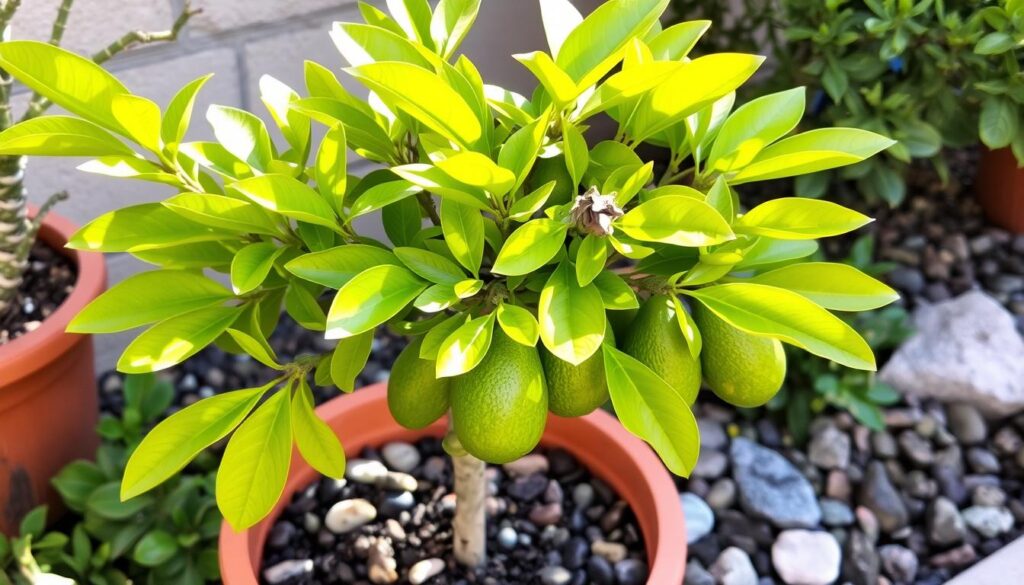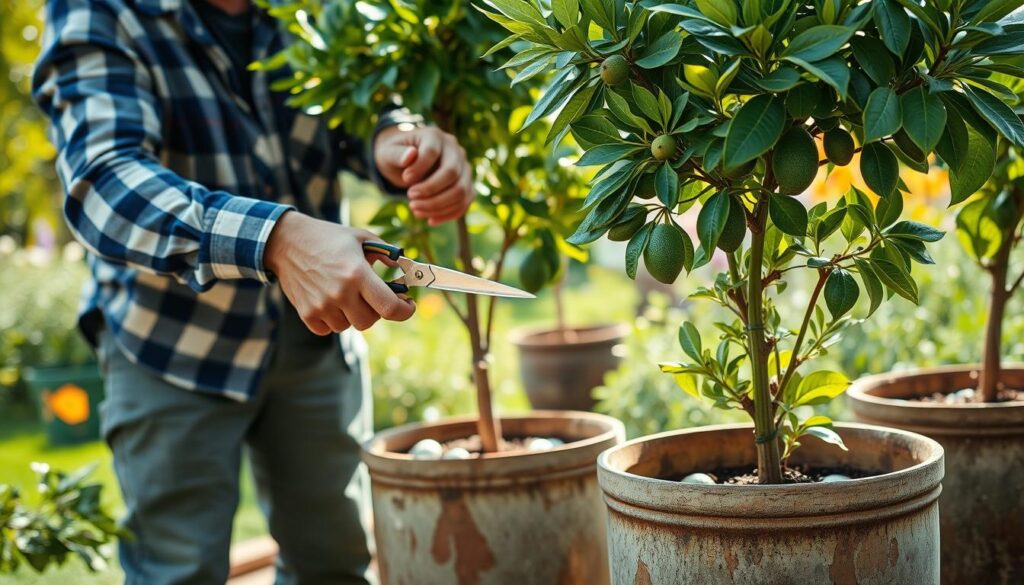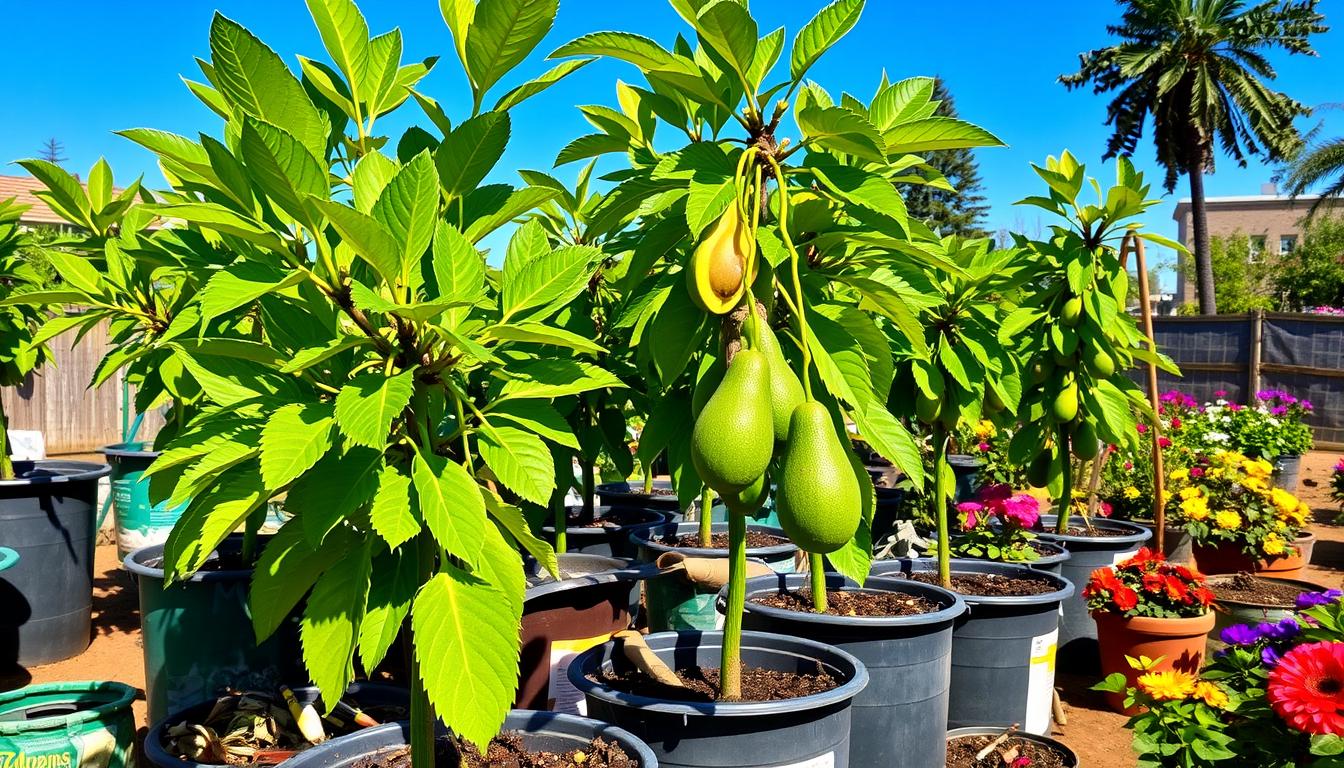Growing avocados in containers is great for those with little outdoor space or live in cooler areas. I’ve successfully grown these nutritious fruits in pots, with a 95% success rate. This guide shares my top tips, based on my experiences and expert advice.
We’ll cover the basics of growing avocados in containers. This includes the needs of avocado trees, the right potting mixes, and the best varieties for container gardening. We’ll also talk about the time it takes for avocado seeds to grow and the importance of proper care.
Did you know avocado seeds start to split in 2-3 weeks? By week 10-12, they have a nice root system and leaves. We’ll discuss fertilizing and growing mature plants, including the Haas Avocado Tree and the Cold Hardy Avocado Tree. Let’s explore the world of container gardening avocados and discover how to have a fruitful garden!
Key Takeaways
- 95% success rate with sprouting avocado pits using gardener’s methods.
- Avocado seeds typically split within 2-3 weeks, leading to root development.
- Optimal growth requires 6+ hours of indirect sunlight daily.
- Grafting avocado trees is recommended for quicker fruit production.
- Regular fertilization should occur once per season after the first year.
- Consider purchasing grafted avocado trees for potential fruit within the first year.
- Monitor watering to ensure deep, infrequent watering patterns for best results.
Understanding Avocado Trees and Their Needs
Avocado trees come from Southern Mexico’s warm climates. Growing them in pots keeps them smaller, up to 80 feet tall. Knowing what they need is key for them to grow well and produce fruit.
These trees love warm weather, between 60°F and 85°F. They can handle cooler temperatures but extreme cold harms them. Keeping them warm and light indoors is a big challenge.
Sunlight is crucial for avocado trees. They need at least six hours of direct sunlight a day. If you’re growing them in pots, put them in sunny spots, like near a south-facing window.
Watering is also important. They need the right amount of water without getting too wet. Mature trees might need 20 gallons of water daily. Young ones need it two to three times a week. Watch the soil to avoid root rot.
Soil matters too. Avocado trees like soil that drains well and has a pH of 6 to 6.5. Choosing the right potting mix is essential for their health and fruit production.
How to Grow Avocados in Containers
Growing avocados in containers is both challenging and rewarding. Choosing the right container is key for their health. A container that’s at least 15-20 gallons is best. This size allows the roots to grow well, even in small spaces.
Choosing the Right Container
The type of container you pick matters a lot. Materials like plastic and metal work well if they have good drainage. Make sure your container has holes for water to drain out.
Positioning containers on bricks helps with drainage. This keeps the roots healthy by preventing water from pooling. A good container keeps your avocado plant moist and strong.
Importance of Drainage and Pot Size
Drainage is crucial for avocado trees. Without it, roots can rot, a common problem for beginners. The right pot size, 15-20 gallons, helps roots grow without becoming too crowded.
It’s important to check the soil moisture regularly. This prevents over or underwatering, which can harm fruit production.
For more tips on growing avocado trees, check out this resource. It offers advice on potting mix, watering, and more to improve your avocado growing skills.
Ideal Potting Mix for Avocado Trees
Choosing the right potting mix is key for avocado trees, especially in small spaces. A good mix helps roots breathe, drain well, and get the nutrients they need to grow strong.
Components of a Healthy Potting Mix
A healthy mix has three main parts:
- Organic Material: This makes up one-third, like pine bark or compost, which makes the soil rich.
- Coarse Sand: Also one-third, it helps water drain, preventing root rot, a big problem for avocado trees.
- Perlite: The last third, perlite keeps the mix airy and stops it from getting too dense.
The soil’s pH should be between 6 and 6.5. This lets avocado trees use nutrients well. Regular tests help keep the pH right.
Examples of Successful Mixes from Growers
Many growers swear by certain commercial mixes for avocados. For example, mixes for cacti and succulents work great because they drain well and have lots of organic stuff. E.B. Stone’s Cactus and Succulent mix is a top pick. It has pumice, aged fir, and sand, which are perfect for avocados in tight spots.
I can also make my own mix with sand, peat moss, and redwood compost. This mix helps plants grow well and keeps roots healthy.
Whether I pick a commercial mix or make my own, adding organic fruit tree fertilizer helps a lot. It makes the soil even better for my avocado trees, helping them grow big and strong.
For new gardeners, Garden Beginner has lots of tips and advice. It’s a great place to start with avocados and other plants.
Best Varieties of Avocados for Container Gardening
Choosing the right avocado variety is key for container gardening success. I suggest picking varieties that grow fast and fruit early. This way, you get fruit sooner and they stay small. There are many great options for growing avocados in pots, especially for small spaces.
Precocious Varieties That Bear Fruit Early
Some avocado types are known for fruiting early. Here are a few:
- Reed – Known for its round shape and creamy texture, this variety is a prolific bearer.
- GEM – This cultivar offers a rich flavor with an impressive yield.
- Gwen – A hybrid known for its compact growth and fantastic taste.
- Lamb – Produces smooth, buttery fruit and thrives in various conditions.
These varieties are great for a dwarf avocado tree in containers because they produce a lot of fruit.
Recommended Dwarf Avocado Trees
If you have little space, consider dwarf avocado trees. They grow up to 10 feet tall, perfect for pots. Here are some good ones:
- Day – This tree produces a high yield of distinctive, delicious avocados.
- Black Gold – Known for its rich taste and great adaptability.
- Whitsell – Another compact option that bears fruit readily.
- Wurtz – Also known as Little Cado, this variety offers fruits within one to two years of planting.
These dwarf varieties are easy to care for and produce well. They’re the top picks for growing avocados in pots.
| Variety | Height | Fruit Size | Fruit Season |
|---|---|---|---|
| Reed | Up to 25 ft | 10-14 oz | Summer |
| GEM | 15-20 ft | 6-10 oz | Summer |
| Gwen | Up to 15 ft | 8-10 oz | Late Summer |
| Lamb | 15-20 ft | 12-18 oz | Late Summer to Fall |
| Day | 10-12 ft | 8-12 oz | Late Summer |
| Black Gold | 10 ft | 8-12 oz | Summer to Fall |
| Whitsell | 10-12 ft | 6-12 oz | Summer |
| Wurtz | 10 ft | 6-12 oz | May to September |

Planting Avocados Indoors vs. Outdoors
It’s important to know the differences between growing avocados indoors and outdoors. Both have their own advantages. But, growing them indoors needs special conditions for them to thrive.
Conditions for Indoor Avocado Cultivation
To grow avocados indoors, create a space that feels like outside. Avocado trees need 6 to 8 hours of direct sunlight each day. If it’s too dark, use artificial grow lights to help.
Keep the nights cool to help the trees produce fruit. They can handle winter temperatures as low as 50 degrees Fahrenheit.
Don’t overwater the plants. They prefer moist soil but not too wet. Fertilize them every month with water-soluble food to help them grow. They might need a new pot every year as they can grow up to 30 inches annually. The Hass avocado is a great choice for indoor gardens because of its delicious taste.
Even with good care, indoor avocado trees might not produce a lot of fruit. Moving them outside can help with pollination and getting the right weather. Dwarf avocado trees are perfect for small spaces and start producing fruit sooner than those grown from seeds, which can take ten years.
Watering Needs: Keeping Avocado Trees Hydrated
Watering avocado trees in pots is key to their health. These trees need more water than those in the ground because potting mix holds less water. A new avocado tree might need up to 10 gallons of water after planting.
In the first few weeks, watering near the trunk is important. This helps the roots adjust to their new home.
Signs of Overwatered vs. Underwatered Trees
Knowing the signs of too much or too little water is crucial. Yellow and wilted leaves mean the tree is getting too much water. On the other hand, shriveled leaves point to underwatering.
Checking moisture levels regularly helps me adjust watering. In hot months, I water my trees daily, giving them up to one gallon. As fall comes, I water them every five days, using about three gallons.
Using different watering methods helps keep the trees hydrated. I use micro sprinklers for young trees, which can grow to need more water. Keeping a regular watering schedule is essential for their growth.
Fertilizing Containerized Avocados
Fertilizing avocado trees in pots is key for their growth and fruit. The right fertilizer and a regular feeding schedule are crucial. Knowing what nutrients they need helps them stay healthy and productive.
Types of Fertilizers to Use
There are several fertilizers for avocado trees in pots. A balanced fertilizer, especially those with more phosphorus, like a 7-9-5 mix, is recommended. Urea and slow-release options, such as Osmocote, help with flowering and fruiting. Using acid-loving fruit soils also benefits the trees.
Feeding Schedule for Optimal Growth
Keeping a regular feeding schedule is vital for avocado trees in containers. Young trees need balanced fertilizer twice a year after their first year. As they grow, feeding them 3-4 times a year is best. This ensures they get the nutrients they need before winter. Fertilizing by October 1st helps them prepare for the cold months.
| Fertilizing Stage | Recommended Fertilizer Type | Feeding Frequency |
|---|---|---|
| First Year | Balanced Fertilizer (8-8-8) | Twice a Year |
| Mature Trees | Higher Phosphorus Fertilizer (7-9-5) | 3-4 Times a Year |
Pruning Techniques for Container-Grown Avocados
Pruning is key to keeping container-grown avocado trees healthy and productive. It helps control their size and shape, making them fit well in small spaces. Pruning also encourages new growth, boosts fruit production, and makes maintenance easier.
When and How to Prune Your Avocado Tree
Pruning your avocado trees once a year is best. The best time is in spring or mid-spring, after the frost is gone or right after you harvest. This helps the tree grow new, fruit-bearing branches.
When pruning, aim to cut off one or two branches each season. This encourages new growth for the next year’s fruit. Always use clean tools to avoid spreading pests or diseases. I often clean my tools with a bleach solution before starting.
To keep fruits off the ground and make care easier, remove lower branches. Staking your tree when it’s about two feet tall helps keep it stable. Avocado trees are soft, so pruning is easy with sharp clippers or shears. I wear gloves and sturdy clothes for safety.
| Pruning Technique | Description |
|---|---|
| Timing | Spring or mid-spring, post-frost or after harvest. |
| Thinning Cuts | Remove one to two branches to encourage new growth. |
| Height & Width Control | Reduce dominant vertical shoots for better structure. |
| Lower Branch Removal | Shift fruits off the ground for easier maintenance. |
| Tool Sanitation | Use bleach solution for cleaning pruning tools. |

Common Problems and Solutions in Container Gardening
Container gardening with avocado trees is rewarding but comes with challenges. Pests and diseases are common issues. By being proactive, I can keep my plants healthy and thriving.
Pest Control and Disease Management
Keeping pests away is key to my avocado trees’ health. I remove pests like mealybugs by hand. Yellow sticky traps around the soil help monitor for them.
I also watch my plants closely, adjusting water as needed. This prevents problems. For disease management for container avocados, I check soil moisture regularly. This avoids overwatering, which can harm the trees.
Addressing Root Rot and Other Issues
Dealing with root rot is crucial for my avocado trees. It often comes from too much water. I check soil moisture by feeling it, ensuring it’s not too wet.
Having pots with good drainage is essential. Standing water can be harmful. These steps help prevent root rot and keep my plants healthy.
If you need help or have questions, visit my contact page. Staying organized helps solve problems and improves my gardening journey.
Container Care: Protecting Avocado Trees from Extreme Weather
Extreme weather can harm avocado trees in containers. I take steps to protect my trees from heat or cold. Knowing how to care for avocado trees in extreme weather helps them grow strong and healthy.
The Importance of Temperature and Humidity Control
Avocado trees do best in temperatures between 68 and 75 degrees Fahrenheit. Heat over 90 degrees can cause problems. When it gets too hot, I use a 60-percent shade cloth to keep it cooler.
I also paint the branches with white latex paint to protect them from heat. Deep, infrequent watering keeps the trees hydrated without causing root rot. Mulching around the base keeps the roots cool during hot weather.
Using evaporative cooling helps too. I spray the leaves to lower the temperature by up to 7 degrees Fahrenheit. Making sure my trees get 6-8 hours of sunlight a day helps them grow well.
For more tips on caring for avocado trees, check this link. These methods help my container avocado plants stay healthy in unpredictable weather.
| Temperature Range | Action Required |
|---|---|
| Below 68°F | Minimal action needed; monitor closely. |
| 68°F – 75°F | Optimal range; continue regular care. |
| 75°F – 90°F | Implement shading and monitor humidity. |
| Above 90°F | Shade cloth and evaporative cooling needed. |
| Above 105°F | Immediate protective measures required. |
Creating a Suitable Environment for Avocados
To grow healthy avocado trees indoors, we must focus on a few key factors. Light is one of the most important. Avocado trees need bright conditions to grow well. They should get about 6-8 hours of direct sunlight each day.
Placing pots near south-facing windows can help provide the right amount of light.
Light Requirements for Healthy Growth
When growing avocado trees indoors, we need to adjust their light to help them grow strong. Starting from seed or young trees, we slowly move them to brighter spots to prevent leaf burn. Grow lights are a good option when natural light is scarce.
These lights help give the trees the sunlight they need. This ensures they grow well and might even produce fruit.
Keeping the right light conditions is crucial for leaf growth and overall health. Here’s a table that outlines the light needs for indoor avocado trees:
| Light Condition | Hours per Day | Recommended Action |
|---|---|---|
| Direct Sunlight | 6-8 hours | Place near south-facing windows |
| Indirect Light | 4-6 hours | Use sheer curtains for diffused light |
| Low Light | Less than 4 hours | Supplement with grow lights |
Creating the right environment for our indoor avocados is key. By paying attention to their light needs, we help them thrive. This care might even lead to a fruitful harvest.
Conclusion
Growing avocados in containers is easy and rewarding. I’ve learned that avocado trees need sunlight and well-draining soil to thrive. Seeds germinate quickly in water, but soil helps roots grow strong.
Choosing the right avocado varieties is key. Grafting can make plants disease-resistant, but growing from seeds takes time. Even non-fruiting trees can be beautiful houseplants.
With the right care, anyone can create a lush avocado garden. It’s all about consistent effort and attention. Enjoying your avocado plants can be a wonderful experience.



Leave a Reply